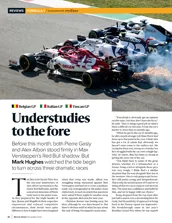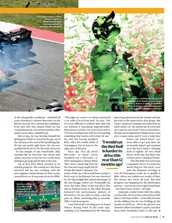

The most successful chassis designer in the MotoGP paddock doesn’t work for Ducati or Honda or Yamaha or any of the other big manufacturers. Alex Baumgärtel works for his own company, Kalex, which has dominated the intermediate Moto2 category for the past decade, winning an incredible 19 riders’ and constructors’ world championships and more than 140 grands prix.
Indeed Kalex has won more GP victories over the last ten years than Ducati, Suzuki and Yamaha combined.
Baumgärtel used to work in the car industry, at Holzer Motorsports, where he designed drivetrains and suspension for Opel DTM cars. However, he’s a motorcycle freak at heart, so around 15 years ago he started building race-bike chassis, just for fun, together with Holzer colleague and fellow bike enthusiast Klaus Hirsekorn.
Their first creation was an immediate success, winning races in Germany.
“We thought, ‘Hmm, maybe this thing isn’t so bad,’” Baumgärtel remembers. “So we said, ‘OK, let’s quit our jobs and try to survive in the motorcycle world.’”
In 2008 the pair established Kalex (a compound of their names Klaus and Alex), with no great aims of world domination. However, they were soon overtaken by events.
“We don’t like having the whole grid–we want to beat our rivals”
In 2010 MotoGP replaced the original 250cc intermediate class with Moto2, which specifies spec engines in prototype chassis. The idea was to reduce costs and encourage smaller constructors to return to GP racing.
“When the Moto2 regulations popped up, we said, ‘This is our chance – let’s invest all we’ve got,’” adds Baumgärtel.
The first Moto2 grid was mostly filled by established motorcycle chassis builders: garagiste enterprises like Bimota in Italy, Harris in the UK, Moriwaki from Japan and Suter from Switzerland. No one had heard of the newcomers from the small town Bobingen, near Munich. And yet one team, owned by former 250cc world champion Sito Pons, saw the promise and bought its frames and swingarms from Baumgärtel and Hirsekorn for Moto2’s inaugural season.
Kalex won the opening race of Moto2’s second season and has hardly stopped winning since. The only thing that’s prevented a full house of riders’ and constructors’ world titles over the past nine years is Marc Márquez, who won both crowns for Suter in 2012.
Baumgärtel has succeeded because he seems to understand the human aspect of motorcycle racing even better than people who have been into two wheels all their lives.
“I enjoy bikes because this black hole that the rider calls ‘feeling’ is super-interesting – you read the rider’s eyes to know if the bike is working or not,” he says. “Car racing is the complete opposite – it’s all data, more or less.”
How you translate the look in a rider’s eyes into a chassis CNC’d from 5083 aluminium alloy is the key to winning motorcycle races. Baumgärtel considers the whole motorcycle to be a kind of spring.
“During the last part of braking the rider is bending the forks and front wheel backwards by maybe half a millimetre, but that’s still a movement,” explains Baumgärtel. “Everything is stressed on the brakes, then the rider releases the brake, so everything relaxes and the wheel and forks move forward by the same amount. You need to control that spring-back in a friendly way.”
Until two decades ago constructors spent a lot of time chasing the assumed Holy Grail: the 100% stiff chassis. Only once they had the engineering capability to achieve that goal did they realise that frames and swingarms don’t work if they’re fully rigid.
“The front and back of the frame and swingarm are strong – you control the stiffness between those areas,” Baumgärtel continues.
Between the front and back of a Kalex chassis the aluminium is just 1.2mm thick at some points, so it pings like a Coke can. This allows the chassis to flex and twist in corners, which helps the tyres to track the asphalt better and the motorcycle to turn better.
And it’s not only the frame and swingarm. In racing, front-end feel is so vital to corner-entry speed and therefore lap times that Kalex offers different upper and lower triple clamps (which connect the front end to the frame) of varying stiffness.
Baumgärtel’s background at Holzer certainly helps, because the company not only works in the better-financed world of car racing but also in aerospace. Therefore his quality control is simply better than his rivals.
“Machining and fabricating are the key points, plus the guy who is doing the welding,” he says. “With high-precision machining we can have everything exactly the same, so we can build two bikes and the rider will get the same feeling from both. This didn’t use to happen. When we started, people told us that a rider could try two of our bikes and be unable to tell the difference, which they said was exceptional. I scratched my head and said, ‘Really?!’”
Kalex doesn’t only dominate the front positions of Moto2 racing – all but four of the 30 riders on this year’s grid will use Kalex chassis.
“We don’t like being called the Kings of Moto2 and we don’t like having nearly the whole grid, because we want to beat our rivals,” Baumgärtel says. “It’s a bittersweet feeling – we don’t want to be the destroyer but also we don’t want to lose!”
Mat Oxley has covered motorcycle racing for many years – and also has the distinction of being an Isle of Man TT winner
Follow Mat on Twitter @matoxley